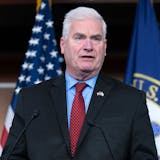Consumers are keeping a close eye these days on swift increases in prices of food, gas and utilities. But another force has squeezed their wallets far more — yet far more slowly.
Since the 1980s, when inflation was last at the levels seen today, spending routines have changed: People now spend less on goods, such as food, and more on services, such as education and health care.
And over the last 20 years, prices for services have tripled. They've grown faster than prices of goods and faster than the wages people need to pay for everything.
"If you're a family with kids and you're paying for their health care or getting them to school or college, it's gotten harder and harder for the average household," said Mark Wright, director of research with the Federal Reserve Bank of Minneapolis.
Consumers are now experiencing sticker shock with every type of consumer good. But electronics, clothing and toys have actually fallen in price over the past two decades when compared with overall inflation.
"Broadly speaking, if you're selling something that's like a physical good, the prices of those things have tended to fall relative to everything else," Wright said. "The price of services like education and health care, they've tended to rise."
And because the need for services tend to be fixed and long term, it's hard to chop them out of the family budget at a moment like now, when meat prices are up about 10% from year-ago levels and gas prices up around 50%.
Less attention has been paid to prices on services recently because they haven't spiked like goods. In the latest Consumer Price Index, for instance, health insurance was up 1.7% in January vs. a year ago while college tuition and fees were up 1.9%. Both were far below the overall inflation rate of 7.5%.

